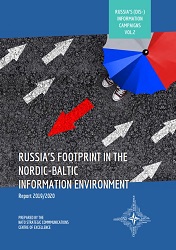Hostile Narratives and Their Impact: The Case of Latvia
Hostile Narratives and Their Impact: The Case of Latvia
Author(s): Māris Cepurītis, Austris Keišs
Subject(s): Politics and communication, Theory of Communication, Crowd Psychology: Mass phenomena and political interactions
Published by: NATO Strategic Communications Centre of Excellence
Keywords: Latvia; hostile narratives; story vs. narrative; strategic communication; impact of hostile narratives; narrative as phenomenon; politics;
Summary/Abstract: Narrative often is compared to a story. But authors of NATO Strategic Communications Centre of Excellence distinguish in their publication ‘Improving NATO Strategic Communications Terminology’ between a story and a narrative, defining story as ‘a temporally, spatially, and casually connected sequence of events’ and a narrative as ‘morals drawn from stories’. Consequently, stories are a way how narrative is communicated and shared between individuals. It is formed and maintained in human memory. In social and political context, narrative can be described as a framework that allows humans to connect apparently unconnected phenomena around some causal transformation.
Book: Russia’s Footprint in the Nordic-Baltic Information Environment. Report 2019/2020
- Page Range: 18-31
- Page Count: 14
- Publication Year: 2020
- Language: English
- Content File-PDF

